Popular Hand Embroidery Techniques from Different Regions of India
Embroidery is a type of art that entails stitching strands of thread on yarn with a needle to create designs on cloth. It is a sophisticated form of art that is used to weave vivid designs into a range of fabrics to raise the value of Indian clothing. Embroidery has been practised in India for hundreds of years and expresses a good amount about the country's culture and traditions. Let's delve a little more into the 10 different types of hand-embroidered techniques used throughout India:
1. Zardosi: Embroidery exuding elegance
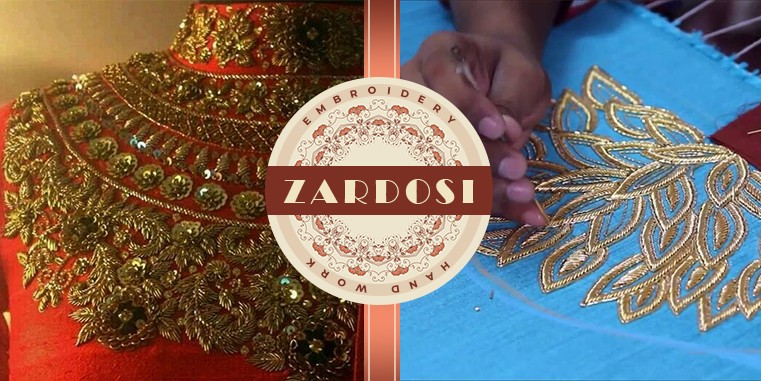
Origin: A Persian form of embroidery gained heavy indulgence during the 17th century and is the form of excellence & opulence. The word Zardosi comes from two Persian words for gold (zari) and embroidery (dosi).
Creation: Silk and velvet were woven with metallic threads. Zardosi embroidered apparel was originally made with gold or silver threads, priceless stones, and pearls, making it a luxury item worn only by the affluent.
Style: While gold-coloured plastic threads were once interpreted as a sign of wealth, gold-coloured plastic threads are now used, making this style of art more accessible to the common folk. Zardosi, which is featured in sarees, suits, blouses, and lehengas, gives you an elegant look that oozes class and allure.
2. Gota: Embroidery for Royalty
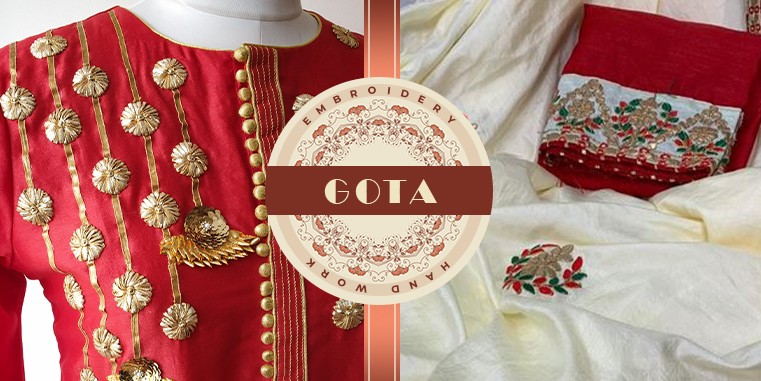
Origin: Originated in Surat, Gujrat but now practised in Jaipur, this embroidery technique uses zari using forms of palaces and maharajas to trace elaborate patterns, creating different surface textures.
Creation: Originally done with gold and silver wires of varying lengths woven in a satin or twill weave. Fabrics such as georgette or bandhini are primly chosen upon which the Gota is appliqued by hemming or backstitching.
Style: With the motifs of nature, Gota embroidery gives a graceful and royal impression. Often chosen for auspicious occasions, clothes decorated with Gota are highly embroidered, looking heavy to carry, but surprisingly light. It is chosen by brides for its unique patterns and lightweight design, variety in colours, and choice of fabrics. Available in suites, dupattas, sarees, ghagras, and lehengas, for an ethnic look meant for celebration, Gota embroidered clothes are the way to go.
3. Chikangari:
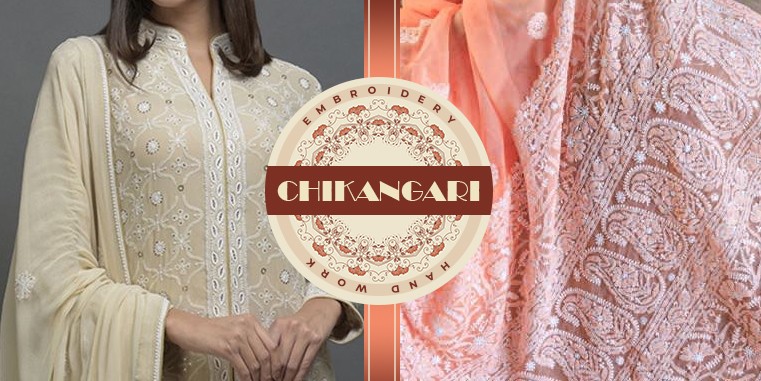
Origin: Chikankari is said to have been introduced by Jahangir's wife, Noor Jahan. It is said to have originated in Lucknow, Uttar Pradesh. It all started with white embroidery on a white fabric, but now it comes in every colour imaginable.
Creation: Requiring patience and skill, this embroidery is done by stitching on patterns traced on a variety of cloth materials like muslin, silk, chiffon, net, cotton, etc. Initially, white thread was used to depict motifs of nature (flora and fauna), but now coloured threads are used as well.
Style: From sarees to suits, lehengas to palazzos, chikan embroidery is chosen by women to showcase elegance which comes guaranteed with the intricacies of the stitches and patterns. Suitable for both daily wear and special occasions, you can make a distinguished style statement whenever you wear chikankari.
4. Aari Embroidery
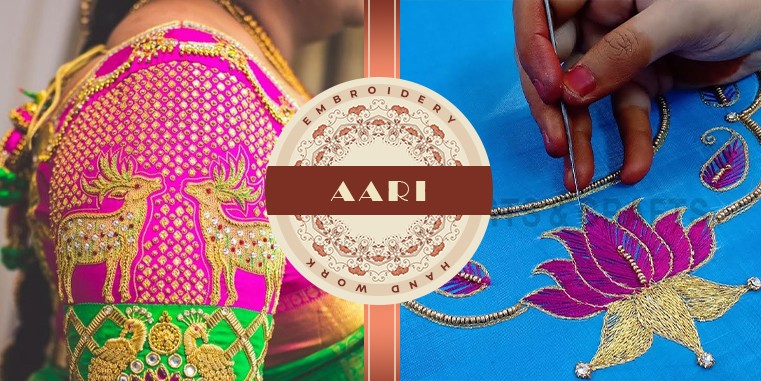
Origin: The name of this embroidery comes from the hooked, sharp needle, which is used for this technique. Aari owes its origin to the Mughals and is practised in Rajasthan, Lucknow, and Kashmir.
Creation: The Aari embroidery is made by using a hooked needle to make chain stitch loops, with beads and sequins often used as ornaments.
Style: Aari distinguishes out for its richness, with highly detailed designs inspired by nature. When the attention is on the saree's body, the blouse is frequently left plain, resulting in an unrivalled design statement. Any cloth with Aari embroidery is easy to maintain and style, and it delivers comfort as well as style.
5. Banjara Embroidery
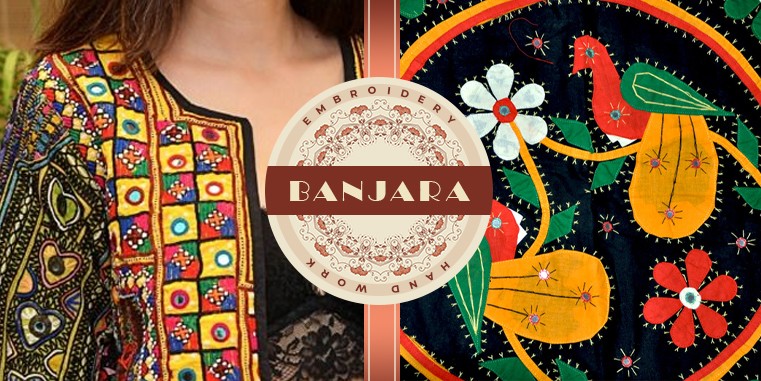
Origin: Banjara's nomadic tribes did not confine themselves to a particular geographical place, allowing this kind of embroidery to spread throughout multiple regions and allow for variation in technique and design.
Creation: The themes for this needlework are highlighted by cross-stitch in geometric designs on a vividly coloured background cloth. Unique motifs are also created using chain stitch and superimposed quilting stitches, which are occasionally adorned with mirrors and beads.
Style: The Banjara embroidery adds vibrancy to the ordinary ethnic style with a combination of patchwork and mirrorwork. It can be found in both contemporary and traditional clothes. Banjara embroidery can be found on gowns, suits, lehengas, blouses, and bags. Banjara embroidered clothing or accessories are the greatest options for a casual and cheerful look. Mixing a Banjara embroidered bag with a western dress, as well as the trademark ethnic style with traditional accessories, can easily create a fusion look.
6. Phulkari Embroidery:
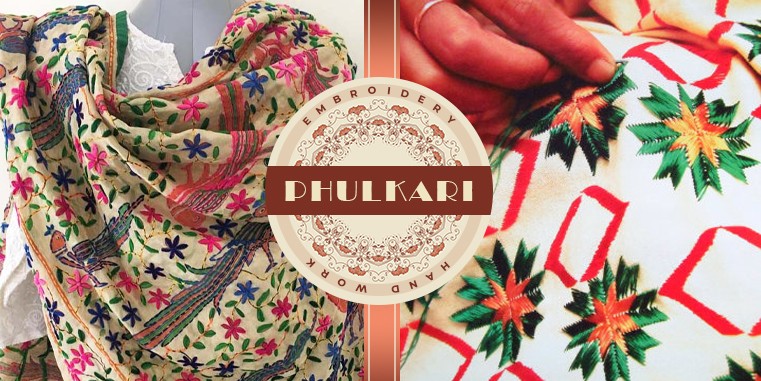
Origin: Phulkari is a rural needlework tradition in Punjab that is mentioned in Heer Ranjha's folklore. Its current form dates from the time of Maharaja Ranjit Singh in the 15th century.
Creation: The foundation material is usually a dull, handspun khadi that is entirely covered with a brightly coloured embroidered design, leaving no gaps. Using darn stitch for easy vertical, horizontal, and diagonal threadwork, each motif follows a geometric design with motifs of nature (mostly florals).
Style: Fabrics such as georgette, chiffon, and cotton are fast replacing khaddar, and machine-made garments, combined with hand-embroidered outfits, have made this style more affordable. With a phulkari outfit, you can't go wrong with mixing and matching. You can simply acquire the correct ethnic style with rusted silver jewellery. For a modern style, Phulkari Kurtis can be worn with women jeans, while lightly embroidered outfits can be worn regularly. Phulkari, which is traditionally a bridal attire, can also be worn for a joyful festive look in a variety of colours.
7. Sheesha/Mirror work:
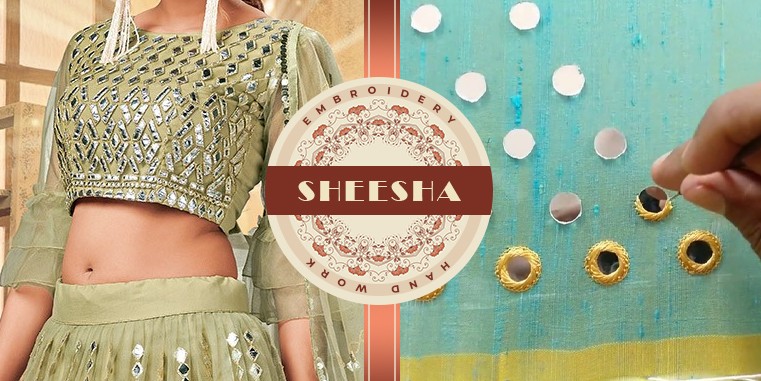
Origin: Mirror work was initially done with Mica and brought into India by Iranian travellers in the 17th century. Mirrorwork is popular in Rajasthan, Haryana, and Gujarat, and its application and style vary according to area and taste.
Creation: Mirrors (of various sizes and shapes) are secured to clothes using a particular cross-stitch, and the fabric is then embellished with matching stitches to enhance the overall beauty of the cloth.
Style: Mirror work is extensively utilised and adored in everything from clothing to accessories. Clothes with Mirrorwork can be worn regularly or for special events, thanks to the variety of possibilities available. Despite the ever-changing fashion trends, mirror work remains popular due to its unique technique to embroidery.
8. Kantha Embroidery:
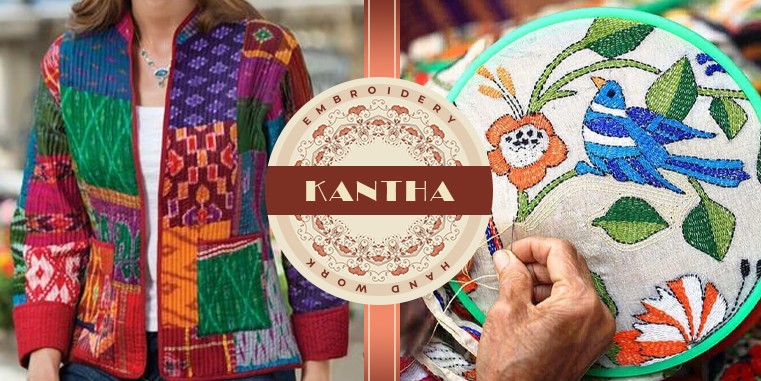
Origin: Kantha needlework is mostly undertaken by rural women in East Indian regions such as West Bengal, Odisha, and Tripura, as well as Bangladesh.
Creation: Kantha embroidery is done by sewing on the cloth, which gives the material a wrinkled and wavy effect, with varied themes of flowers, animals, celestial objects, and geometric designs. Kantha is now used in men's and women's dupattas and shirts, as well as cushions, blankets, sarees, and bedspreads.
Style: Fashion and comfort have reached new heights with Kantha embroidery now available on kurtas and suits. Kantha needlework, which exudes a sense of relaxation, can be chosen for its richness, which completes any style without the need for other accessories. The fabric is simple to care for and style, adaptable to a variety of occasions, and simply fashionable.
9. Kashmiri or Kashida Embroidery:
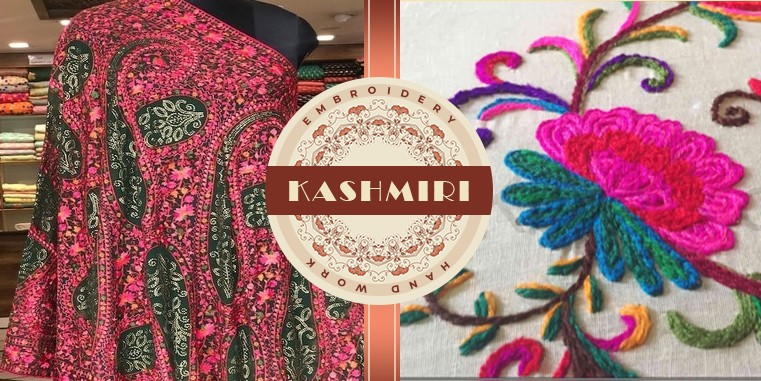
Origin: The name of this needlework comes from the place where it was created, Kashmir. The material for this needlework, also known as Kashida embroidery, was woven and embroidered by members of the same, frequently extended, family.
Creation: Base designs are formed using dark-colored woollen clothing in the winter and light (and bright)-coloured cotton clothing in the summer. A single stitch is utilised for each design, and the entire pattern takes only a few stitches to finish. Everything related to flora, from flowers to intertwined vines, from leaves on branches to budding blooms, is a popular motif.
Style: Especially in the winter, Kashmiri embroidery is a popular choice among ladies. Pashmina shawls are well-known, and Kashmiri suits are popular for their vibrancy and warmth, as well as their unusual appearance. You can't go wrong with Kashmiri embroidery when paired with embroidered juttis and oxidised silver jewellery.
10. Toda Embroidery
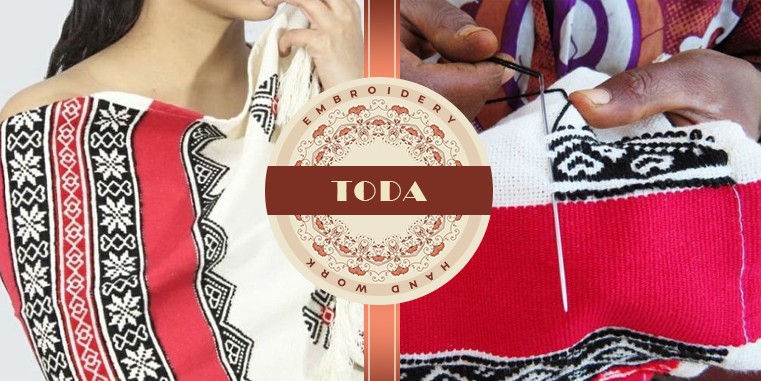
Origin: Toda embroidery, also known as 'pohor' (flower) in the Toda language, is made by the Toda tribe, who live in the Nilgiri Hills of Tamil Nadu. Toda ladies are the only ones who practise it.
Creation: Toda needlework displays motifs of nature and/or heavenly bodies in a geometrical design, traditionally utilising black and red woollen threads on a coarse white material. For a reverse stitch approach, a single stitch darning needle is used, which creates a design that appears to emerge from the material, giving the object a rich appearance.
Style: On certain occasions, such as weddings and funerals, the Toda men and women wear cloaks and shawls with this embroidery. Embroidery is no longer limited to bedsheets and cushion covers. Apart from cloaks and shawls, Toda embroidery has made its way onto sarees, which are ideal for an ethnic style with a distinct Toda embroidered edge.
Whether you pick for Zardosi or Phulkari, Kashmiri or Gota, Shisha or Chikankari, embroidery never goes out of vogue when it comes to making a fashion statement, bringing a sense of flair and excellence to your outfit.
Latest Posts
Categories
Tags


 +1-403-351-7777
+1-403-351-7777














